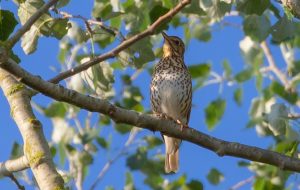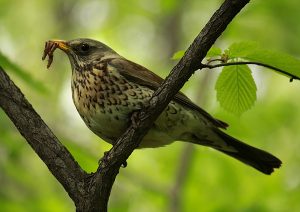It probably won’t have escaped your attention that there are fewer thrushes visit our gardens than ever before. For me, it is a rare and exciting treat to spot some, particularly if they are helping themselves to the treats in the ground feeder or nesting in the hedgerows.
I decided to look a little deeper to find out if thrushes are in decline, and if so, the possible causes and if there is anything we can do to stop it.

Sadly, the song thrush population has been in decline for decades with approximately 54% fewer birds now than in 1969. The biggest decline is on areas of heavily farmed arable land.
The figures are worrying enough that the BTO have Red Listed the song thrush, the is a serious conservation concern.
The worst part is that no-one has a definitive answer as to why it is happening, although many studies are ongoing.
Table of Contents
Why are Thrushes in Decline
There are many theories around dwindling numbers of thrushes, most of which discuss the changes in farming practices.
Loss of favoured feeding and nesting habitats
As farmer’s fields grow bigger, hedgerows, copses, rough ground and verges disappear. These are the preferred nesting spots of thrushes.
Increased land drainage and tilling, (stirring and mixing up the soil in preparation for planting) reduced the number of worms and small invertebrates in the soil, essential components of the thrushes diet.
Farmers increasingly plant more crops in areas that used to be grassland, resulting in less food for the birds.
- Areas of high levels of arable farming tend to drive thrushes to gardens on the hunt for food and nesting sites. Here thrushes will breed 2 or 3 times a season.
- Areas of mixed farming tend to hold more stable thrush territories, where the birds might attempt 4-5 broods per year.
Pesticides
Molluscicides used in crops wipe out slugs, snails, and earthworms. These represent the vast majority of the song thrushes diet.

Predators
Although the thrush decline isn’t thought to be massively linked with predation, it is a consideration.
They are passerines, which means they perch on branches, leaving them open to attack.
Their poor choices of nesting sites make their nests accessible to cats and foxes, and other birds such as magpies and jays.
Thrushes have a very low mortality rate, with only 20% of fledgeling birds and 60% of adults surviving to breed the following spring. If a thrush makes it through the juvenile months to reach their first year, their chances of survival vastly increase.
Can the Decline of the Thrush be Stopped
There are always ways to help the number of song thrushes increase, whether or not we can halt their decline can only be seen.
Initial measures seem to be in the hands of farmers, with Government initiatives offering grants for planting they choose to undertake.
- Be sympathetic with hedgerows, leave them in situ and let them grow tall, thick, and lush.
- Woodland areas attract the thrush, cash injections are available to plant wooded areas on areas not used for crops.
- The thrush loves leafy clover and prefers to eat in its shade or close by. Plant lots of clovers and wild seed mixtures to grow a bird dining extravaganza. Red millet, dwarf sunflower, linseed, mustard, spring wheat, and barley are just some of the most enticing seeds.
- Irrigation methods that keep the soil damp and full of earthworms have great success. Thrushes will steer clear of soil that has been allowed to dry out during the summer.
Final thoughts…
It’s sad to think that thrushes are in decline, and that is probably the fault of man.
If we all pull together and do our part, we can encourage them back to farmland, woodland, and our gardens, where they can thrive.
With agri-environmental schemes available, the Government has recognised the need to incentivise farmers to help our most threatened garden birds.

Moved to a new area and have been leaving good out to the birds but seem to attract wood pigeons but yesterday 2 Stream thrushes came several times times. I would love them to keep visiting what’s the best food to tempt them?
https://www.gardenbirdfeeder.co.uk/what-do-thrushes-eat/
You should find all the info you need here 🙂